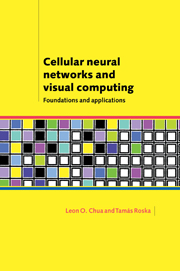Book contents
- Frontmatter
- Contents
- Acknowledgements
- 1 Introduction
- 2 Notation, definitions, and mathematical foundation
- 3 Characteristics and analysis of simple CNN templates
- 4 Simulation of the CNN dynamics
- 5 Binary CNN characterization via Boolean functions
- 6 Uncoupled CNNs: unified theory and applications
- 7 Introduction to the CNN Universal Machine
- 8 Back to basics: Nonlinear dynamics and complete stability
- 9 The CNN Universal Machine (CNN-UM)
- 10 Template design tools
- 11 CNNs for linear image processing
- 12 Coupled CNN with linear synaptic weights
- 13 Uncoupled standard CNNs with nonlinear synaptic weights
- 14 Standard CNNs with delayed synaptic weights and motion analysis
- 15 Visual microprocessors – analog and digital VLSI implementation of the CNN Universal Machine
- 16 CNN models in the visual pathway and the “Bionic Eye”
- Notes
- Bibliography
- Exercises
- Appendices
- Index
10 - Template design tools
Published online by Cambridge University Press: 28 May 2010
- Frontmatter
- Contents
- Acknowledgements
- 1 Introduction
- 2 Notation, definitions, and mathematical foundation
- 3 Characteristics and analysis of simple CNN templates
- 4 Simulation of the CNN dynamics
- 5 Binary CNN characterization via Boolean functions
- 6 Uncoupled CNNs: unified theory and applications
- 7 Introduction to the CNN Universal Machine
- 8 Back to basics: Nonlinear dynamics and complete stability
- 9 The CNN Universal Machine (CNN-UM)
- 10 Template design tools
- 11 CNNs for linear image processing
- 12 Coupled CNN with linear synaptic weights
- 13 Uncoupled standard CNNs with nonlinear synaptic weights
- 14 Standard CNNs with delayed synaptic weights and motion analysis
- 15 Visual microprocessors – analog and digital VLSI implementation of the CNN Universal Machine
- 16 CNN models in the visual pathway and the “Bionic Eye”
- Notes
- Bibliography
- Exercises
- Appendices
- Index
Summary
During the first years after the introduction of the CNN paradigm, many templates were designed by cut-and-try techniques, playing with a few nonzero template elements, and using a simulator to calculate the CNN dynamics. After a while, some systematic design methodologies emerged. Today several methods are available for generating CNN templates or algorithms, even for complex tasks.
Various design techniques
The main classes of design techniques are as follows:
systematic methods for binary I/O function via Boolean description and decomposition techniques using uncoupled CNN (see Chapters 5, 6, 7)
systematic methods for binary I/O function using coupled CNN (see also Chapter 12)
global optimization techniques as parameter optimization
genetic algorithms for designing the template elements/synaptic weights
matching with the spatially discrete representations of partial differential equations (PDEs)
matching with some neuromorphic models of a living organism, typically the nervous system, in particular the visual pathway of vertebrates (see Chapter 16)
fuzzy design techniques
neural network techniques
matching with existing 2D or 3D algorithms, including techniques in signal processing, telecommunications, adaptive control, nonlinear spatio-temporal dynamical systems, etc.
We have to emphasize, however, that, in spite of the many design techniques, new methods are emerging day by day based on the intuition and skill of the designers. A good example for this is a recent method using active waves applied for a while and combining/colliding with other waves, as well as a method in which a wave metric is used for complex pattern recognition tasks.
Information
- Type
- Chapter
- Information
- Cellular Neural Networks and Visual ComputingFoundations and Applications, pp. 258 - 266Publisher: Cambridge University PressPrint publication year: 2002
Accessibility standard: Unknown
Why this information is here
This section outlines the accessibility features of this content - including support for screen readers, full keyboard navigation and high-contrast display options. This may not be relevant for you.Accessibility Information
- 1
- Cited by
